#indian cucumber-root
Explore tagged Tumblr posts
Text














I snuck in a late spring hike in Cheat River Canyon yesterday, before the dreaded heat dome builds in early next week. Between Brazil's Pantanal going up in flames and the massive heat spikes in North America and elsewhere, I wonder what will be left of this planet's beautiful wild places in twenty to thirty years. For now, I celebrate and cherish every day the glorious diversity of living things that nature has gifted us. This includes the magnificent poke milkweed (Asclepias exaltata), a shade tolerant member of the dogbane family, which feeds and hosts a great many of those living things, such as the extraordinary Himmelman's plume moth (Geina tenuidactylus). Or the comical-looking rock harlequin (Corydalis sempervirens), which clings to the rocky outcrops of the canyon. And the exquisite downy skullcap (Scutellaria incana), a gregarious summer mint that associates with wild bergamot and tall thimbleweed at forest edges. And how about the peculiar dangling flowers of Indian cucumber (Medeola virginiana) or the pale, ghostly stems and bracts of the parasitic Indian pipe (Monotropa uniflora), just now emerging from the forest floor? In a couple of weeks, the rhododendron bloom will start in the canyon and summer will be in full swing.
#appalachia#vandalia#west virginia#wildflowers#flora#spring#cheat river canyon#cheat view#cheat river#snake hill wildlife management area#poke milkweed#bumblebee#insects#himmelman's plume moth#daisy fleabane#rock harlequin#downy skullcap#hoary skullcap#indian cucumber#indian cucumber-root#indian pipe#ghost plant#black-eyed susan
63 notes
·
View notes
Text
Honoring the Lady's Slippers
It’s become a tradition for us to spend Memorial Day or at least a day during this weekend searching for one of My Guy’s favorite blooms. I don’t even remember how the count began, but now he cannot not count them. What we’ve learned over the years is that they like a variety of habitats. from dark forests to bogs, and even mountain tops. And they like to hide. So we must really don our Lady’s…

View On WordPress
#Clintonia#Common Whitetail Skimmer#Indian Cucumber-root#Lady&039;s Slipper#Maine#Memorial Day#western Maine
0 notes
Text

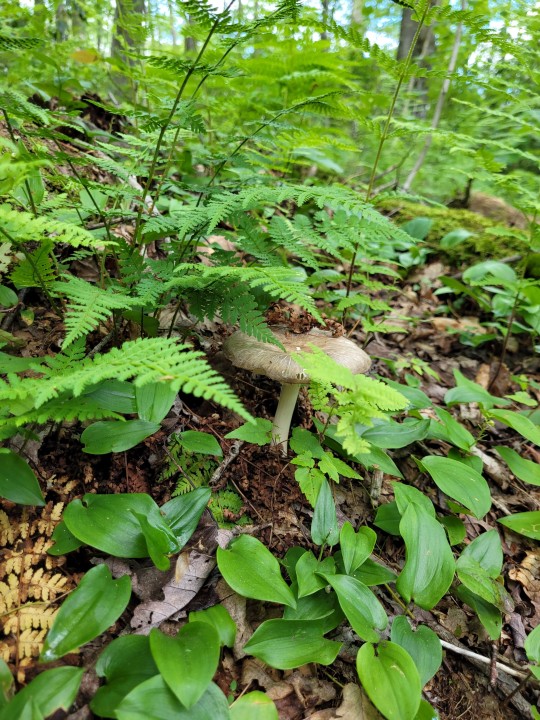



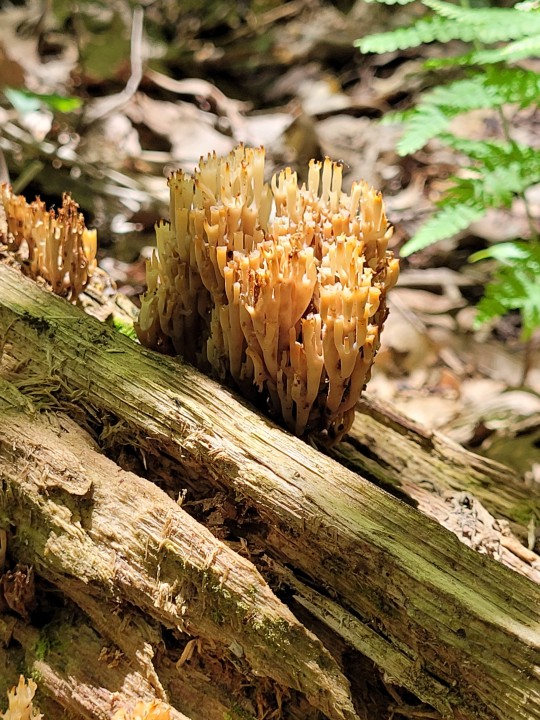

Was finally able to get myself out into the forest last week, after a difficult month. I'm sad to have missed the May ephemerals, but was glad to catch the mountain laurel blooming. These are from June 9th, and the laurels seemed to be at their peak.
Life continues to get in the way of my favorite hobby; I desperately need to learn to drive if I want to hike without relying on someone else's schedule.
#sooo much canada mayflower and sessile bellwort and indian cucumber root. mostly done flowering already#mountain laurel#hiking#native plants#wildflowers#laurel highlands#laurel ridge#mine
3 notes
·
View notes
Text
How to Create a Balanced Indian Vegetarian Meal
Indian cuisine offers a diverse and delicious range of vegetarian dishes that are not only flavourful but also nutritionally balanced. A well-planned Indian vegetarian meal provides a perfect combination of proteins, carbohydrates, healthy fats, and essential vitamins. Whether you are dining at an Indian restaurant Sutherland or preparing a meal at home, understanding how to create a balanced plate ensures a satisfying and nourishing experience.
The Key Components of a Balanced Indian Vegetarian Meal
A traditional Indian meal is designed to provide all essential nutrients through a variety of ingredients. Here are the fundamental components:
1. Protein-Rich Elements
Protein is a crucial macronutrient for muscle growth and overall health. In Indian vegetarian meals, protein sources include:
Lentils (Daal) – A staple in Indian cuisine, lentils such as moong, masoor, and toor provide an excellent protein source.
Chickpeas and Kidney Beans – Used in dishes like chana masala and rajma, these legumes add a hearty texture.
Paneer (Indian Cottage Cheese) – A versatile ingredient used in curries and grilled dishes.
Yoghurt and Buttermilk – Apart from being rich in protein, they also aid digestion.
2. Healthy Carbohydrates
Carbohydrates provide energy, and Indian meals incorporate a variety of whole-grain options:
Whole Wheat Roti or Naan – Provides fibre and sustains energy levels.
Basmati Rice or Brown Rice – Brown rice is a healthier alternative, offering more fibre and nutrients.
Millets and Quinoa – Increasingly popular for their nutritional benefits.
3. Essential Fats
Healthy fats are crucial for brain function and overall well-being. Indian meals include:
Ghee (Clarified Butter) – Adds flavour and aids digestion when used in moderation.
Mustard and Coconut Oil – Used in different regional cuisines for their unique taste and health benefits.
Nuts and Seeds – Almonds, cashews, and sesame seeds enhance both nutrition and taste.
4. Vegetables for Fibre and Micronutrients
A colourful variety of vegetables ensures a well-rounded nutrient intake:
Leafy Greens – Spinach, fenugreek, and mustard greens provide iron and fibre.
Root Vegetables – Carrots, beetroots, and potatoes add essential vitamins.
Gourd Vegetables – Bottle gourd, ridge gourd, and pumpkin aid digestion.
5. Flavour Enhancers: Spices and Herbs
Indian cooking is incomplete without aromatic spices, many of which have health benefits:
Turmeric – Anti-inflammatory and immunity-boosting.
Cumin and Coriander – Aid digestion and enhance flavour.
Ginger and Garlic – Natural antioxidants with medicinal properties.
Fenugreek and Asafoetida – Help in digestion and add a unique taste.
Structuring a Nutritious Indian Vegetarian Meal
Creating a well-balanced meal involves combining the above components in an appealing and wholesome way.
A Sample Balanced Indian Vegetarian Meal Plan
Here’s how you can structure a nutritious Indian vegetarian meal:
Breakfast
Moong Dal Chilla (Savoury Pancake) with Mint Chutney – A protein-packed start to the day.
Masala Chai or Buttermilk – A refreshing drink for digestion.
Lunch
Dal Tadka (Lentil Curry) with Brown Rice – A perfect balance of protein and carbs.
Aloo Gobi (Potato and Cauliflower Sabzi) – Adds essential vitamins and minerals.
Cucumber and Tomato Raita – A cooling yoghurt-based side dish.
Whole Wheat Roti – A source of fibre and complex carbohydrates.
Evening Snack
Roasted Chickpeas or Masala Peanuts – A healthy, crunchy snack.
Fresh Fruit or Nuts – A natural energy booster.
Dinner
Palak Paneer with Jeera Rice – A protein-rich and iron-packed meal.
Beetroot and Carrot Salad – Adds freshness and fibre.
Lassi or Herbal Tea – A soothing way to end the day.
Tips for Making Your Meal More Balanced
Portion Control: Maintain a balance between carbs, protein, and fats to avoid excessive calorie intake.
Use Minimal Oil: Opt for healthier cooking methods like steaming, grilling, or roasting.
Include Fermented Foods: Yoghurt, dosa, and idli aid digestion and promote gut health.
Stay Hydrated: Drink plenty of water, herbal teas, or coconut water for overall well-being.
A well-balanced Indian vegetarian meal combines a variety of ingredients to ensure optimal nutrition and delicious flavours. Whether you are dining at an Indian restaurant Sutherland or cooking at home, incorporating diverse vegetables, protein sources, whole grains, and healthy fats will create a satisfying and nourishing meal. By understanding the essential components of Indian vegetarian cuisine, you can enjoy both the taste and health benefits it offers.
Sylvania Indian Restaurant
8 Princes Hwy,
Sylvania NSW 2224,
Australia
02 9544 9788

0 notes
Text
How to Stay Fresh All Day with Ayurvedic Face Care Solutions
In today's fast-paced world, maintaining fresh and radiant skin throughout the day can be challenging. Pollution, stress, and an unhealthy lifestyle take a toll on your skin, leaving it dull and tired. But the secret to achieving a natural glow lies in the ancient wisdom of Ayurveda. Ayurvedic face care solutions not only rejuvenate your skin but also ensure lasting freshness. Let’s dive into how you can stay fresh all day with the help of Ayurvedic face care routines and products.

The Ayurvedic Approach to Face Care
Ayurvedic, an ancient Indian holistic healing system, emphasizes balance in mind, body, and spirit. When it comes to skincare, Ayurvedic skin care treatment believes in using natural ingredients to cleanse, nourish, and protect your skin. Unlike chemical-based products, Ayurvedic face care products are gentle, sustainable, and free from harmful toxins. They work in harmony with your skin type, addressing the root cause of common skin issues.
Morning Rituals for Fresh Skin
Start your day with a refreshing Ayurvedic face care routine to awaken your skin and set the tone for the day:
1. Cleansing with Herbal Ingredients:
Use a gentle face cleanser infused with natural ingredients like neem, turmeric, and aloe vera. These herbs have antibacterial and anti-inflammatory properties that cleanse the skin without stripping away its natural oils.
2. Hydrate with a Toner:
Spritz a rose water toner to balance your skin’s pH level and tighten pores. Rose water’s cooling properties leave your skin feeling refreshed.
3. Moisturize with Natural Oils:
Choose a lightweight Ayurvedic face serum containing ingredients like sandalwood or saffron. These ingredients not only hydrate the skin but also add a subtle, natural glow.
4. Apply Sunscreen:
Protect your skin from UV damage with an Ayurvedic sunscreen rich in minerals and herbal extracts. Ingredients like aloe vera and coconut oil provide a natural shield against the sun.
Also read: 5 Ayurvedic Night Time Skincare Routine for Ageless Beauty
Midday Skincare Tips for a Quick Refresh
Afternoons can make your skin look oily or tired. Here are some simple ways to stay fresh:
1. Keep Facial Wipes Handy:
Use Ayurvedic facial wipes infused with cucumber or mint extracts to wipe away excess oil and impurities without disturbing your makeup.
2. Refresh with a Face Mist:
A spritz of Ayurvedic face mist containing tulsi or chamomile can instantly revive your skin and give you an energy boost.
3. Stay Hydrated:
Drinking plenty of water is mandatory for keeping your skin hydrated from within. Infuse your water with herbs like mint or slices of citrus fruits for added detox benefits.
Evening Routine to Restore and Rejuvenate
As the day ends, your skin needs extra care to recover from environmental stressors. Here’s how Ayurveda can help:
1. Double Cleansing:
Begin with an oil-based Ayurvedic cleanser to remove makeup and impurities. Follow up with a herbal face wash for a thorough cleanse.
2. Exfoliation:
Use a mild Ayurvedic scrub with ingredients like walnut or oats once or twice a week to remove dead skin cells and improve blood circulation.
3. Nourishing Face Masks:
Apply a soothing face mask made with Multani mitti (Fuller’s earth) and rose water. This mask helps detoxify the skin and restore its natural glow.
4. Night Cream or Serum:
Before bed, massage your face with an Ayurvedic night cream or serum enriched with ingredients like kumkumadi tailam (a blend of 16 herbs). This will repair your skin overnight and keep it supple.
Diet and Lifestyle for Radiant Skin
Ayurveda teaches that beauty is a reflection of your inner health. Make these tips a part of your everyday routine and watch the difference unfold!
1. Eat Fresh and Balanced Meals:
Include plenty of fruits, vegetables, and whole grains. Antioxidant-rich foods, such as vibrant berries and nutrient-packed leafy greens, play a vital role in combating harmful free radicals.
2. Practice Yoga and Meditation:
Regular yoga and meditation reduce stress and improve blood circulation, which benefits your skin.
3. Get Adequate Sleep:
A good night’s sleep is essential for your skin to rejuvenate and repair itself.
Why Choose Ayurvedic Products for Skin Care?
Ayurvedic face cream for daily use are crafted from natural ingredients that nourish your skin without causing harm. They’re free from parabens, sulfates, and artificial fragrances. Moreover, these products are eco-friendly and sustainable, making them a great choice for conscious consumers.
Discover Tree Extract’s Ayurvedic Skin Care Range
When it comes to premium Ayurvedic face care solutions, Tree Extract stands out as a trusted brand. Our organic products are meticulously formulated with the finest natural ingredients to suit all skin types. From hydrating cleansers to nourishing night creams, we offer a wide range of skincare essentials that cater to your daily needs.
Why Tree Extract?
100% natural and toxin-free
Made with sustainably sourced ingredients
Suitable for all skin types.
Stay fresh, stay glowing—the Ayurvedic way!
0 notes
Text
What is the Most Popular Malaysian Food?
Malaysia is a food lover's paradise, offering a rich blend of flavors inspired by its multicultural heritage. From fragrant spices to hearty broths, Malaysian cuisine has something for everyone. Among the many dishes that Malaysia is famous for, Nasi Lemak stands out as the most popular and beloved food.
Nasi Lemak: A National Favorite
Nasi Lemak is often referred to as Malaysia's national dish. It is a simple yet flavorful meal that captures the essence of Malaysian cooking. The dish consists of fragrant rice cooked in coconut milk and pandan leaves, accompanied by a variety of sides. Common accompaniments include sambal (a spicy chili paste), boiled or fried egg, crispy fried anchovies, peanuts, and cucumber slices.
For those seeking a heartier version, many Malaysian restaurants offer Nasi Lemak with fried chicken, rendang (spicy meat stew), or sambal prawns. The combination of creamy rice and spicy sambal makes this dish an unforgettable culinary experience.
Satay: A Grilled Delight
Another iconic Malaysian food is Satay, a favorite for both locals and visitors. Satay consists of marinated meat skewers grilled over charcoal, giving them a smoky flavor. The skewers are usually served with a peanut sauce, cucumber, and onion slices. Whether you choose chicken, beef, or lamb, this dish is perfect for sharing and is commonly found at night markets and Malaysian restaurants.
Char Kway Teow: A Street Food Classic
For fans of stir-fried noodles, Char Kway Teow is a must-try. This dish is made with flat rice noodles stir-fried in a hot wok with soy sauce, shrimp, cockles, bean sprouts, and Chinese sausage. A good plate of Char Kway Teow is smoky and slightly charred, a flavor locals call "wok hei" (breath of the wok). Many Malaysian restaurants offer their unique take on this dish, making it a favorite among noodle lovers.
Rendang: A Taste of Tradition
Rendang is a slow-cooked, spicy meat dish that originates from the Malay and Minangkabau communities. Often made with beef, the meat is simmered for hours in a rich blend of coconut milk and spices until it becomes tender and flavorful. Rendang is not only popular in Malaysia but is also recognized worldwide for its delicious taste. Many Malaysian restaurants include this dish on their menu, especially during festive seasons.
Roti Canai: A Versatile Flatbread
Roti Canai is a versatile dish that can be enjoyed any time of the day. This flaky, buttery flatbread is typically served with dhal (lentil curry) or chicken curry. Its origins are rooted in Indian cuisine, but it has become a staple in Malaysian food culture. You’ll find Roti Canai at roadside stalls and upscale Malaysian restaurants alike.
Conclusion
Malaysian food is diverse and full of flavors that reflect the country’s multicultural heritage. While Nasi Lemak holds the title of the most popular dish, other dishes like Satay, Char Kway Teow, Rendang, and Roti Canai also enjoy widespread admiration. If you’re craving authentic Malaysian flavors, many Malaysian restaurants worldwide serve these beloved dishes, giving you a taste of Malaysia no matter where you are.
0 notes
Text
Fat loss breakfast Indian

Fat Loss Breakfast Options in Indian Cuisine
A fat loss-friendly breakfast is essential for kick-starting your metabolism and setting the tone for the rest of the day. In Indian cuisine, you can focus on meals that are nutrient-dense, low in refined carbohydrates, and rich in fiber and protein. These elements help with satiety, prevent overeating later in the day, and support steady energy levels. Here's a discussion on fat loss breakfast options that are effective, flavorful, and rooted in Indian dietary practices.
1. Importance of a Healthy Breakfast for Fat Loss
Breakfast is often called the most important meal of the day because it provides the necessary nutrients and energy to kick-start your metabolism. A well-balanced breakfast helps in:
Regulating blood sugar levels: Foods rich in protein and fiber can help regulate blood sugar levels, reducing the risk of insulin spikes and crashes.
Increasing metabolism: Protein-rich foods boost metabolism and promote fat-burning processes.
Preventing overeating: A filling breakfast prevents hunger pangs throughout the day, reducing unhealthy snacking and overeating.
Supporting muscle preservation: Protein ensures that muscle mass is maintained, which is essential for boosting metabolism.
2. Key Components of a Fat Loss Breakfast
For a fat loss-focused breakfast, include foods that provide the right balance of macronutrients:
A. Protein:
Protein is crucial for muscle building and fat loss. It promotes fullness and helps reduce cravings, keeping you satisfied for longer periods. Protein also increases thermogenesis, the process of burning calories for energy.
Sources of Protein: Eggs, paneer (cottage cheese), Greek yogurt, tofu, dals (lentils), chickpeas, or sprouted grains.
B. Fiber:
High-fiber foods aid digestion, promote fullness, and help regulate blood sugar levels. Fiber helps in slow release of energy, which can prevent hunger pangs and unhealthy snacking.
Sources of Fiber: Whole grains (oats, quinoa, bajra, jowar), vegetables (spinach, kale, cucumber, tomatoes), and fruits (apples, berries, guava).
C. Healthy Fats:
Including healthy fats in your breakfast supports hormone regulation, boosts brain function, and keeps you satisfied. It also helps in the absorption of fat-soluble vitamins (A, D, E, K).
Sources of Healthy Fats: Avocados, nuts (almonds, walnuts), seeds (chia, flaxseeds), and coconut oil.
D. Complex Carbohydrates:
Unlike refined carbs, complex carbohydrates break down slowly, providing sustained energy without spiking insulin levels. They are high in fiber and help regulate hunger.
Sources of Complex Carbs: Whole grains, millets (foxtail millet, barnyard millet), legumes, and vegetables.
3. Fat Loss Breakfast Ideas in Indian Cuisine
Here are some fat loss-friendly breakfast ideas using traditional Indian ingredients that combine the principles of protein, fiber, and healthy fats.
A. Moong Dal Chilla (Lentil Pancakes)
Ingredients: Moong dal (green gram), ginger, green chili, turmeric, cumin, coriander powder.
Preparation: Soak moong dal overnight and blend into a smooth batter with spices. Cook the batter on a non-stick pan with a little ghee or oil to make thin, crisp pancakes.
Why it's great: Moong dal is rich in protein and fiber, which helps keep you full and energized. The low-calorie chilla makes for an ideal meal to promote fat loss.
B. Vegetable Upma with Millet (Bajra/Jowar)
Ingredients: Bajra (pearl millet), mixed vegetables (carrots, peas, beans), mustard seeds, curry leaves, ginger, green chilies.
Preparation: Dry roast the bajra flour, and then cook it with water, vegetables, and spices until it reaches a soft, porridge-like consistency.
Why it's great: Bajra is high in fiber and low in glycemic index, which helps in weight management by providing slow-releasing energy. The addition of vegetables ensures you’re getting a variety of nutrients.
C. Oats Idli
Ingredients: Oats, semolina (rava), yogurt, mustard seeds, curry leaves, grated carrot, and ginger.
Preparation: Grind oats into a fine powder and mix with semolina, yogurt, and vegetables. Steam in idli molds to prepare soft idlis.
Why it's great: Oats are a rich source of soluble fiber, which helps in controlling blood sugar levels and promoting fat loss. Idlis are low in calories and easy to digest.
D. Poha with Vegetables and Peanuts
Ingredients: Poha (flattened rice), onions, peas, carrots, peanuts, mustard seeds, turmeric, curry leaves.
Preparation: Rinse poha thoroughly, then sauté it with mustard seeds, vegetables, peanuts, and turmeric. Cook for 5-7 minutes.
Why it's great: Poha is light yet filling, and the added vegetables provide fiber, while peanuts contribute healthy fats and protein.
E. Sprouts Salad with Lemon and Olive Oil
Ingredients: Sprouted moong beans, chopped cucumbers, tomatoes, onions, lemon juice, olive oil, black salt, and pepper.
Preparation: Mix the sprouted beans with chopped vegetables and drizzle with lemon juice and olive oil. Sprinkle with black salt and pepper.
Why it's great: Sprouts are a great source of plant-based protein and fiber. This refreshing salad boosts metabolism and aids digestion while being low in calories.
F. Greek Yogurt with Flaxseeds and Berries
Ingredients: Unsweetened Greek yogurt, fresh berries (strawberries, blueberries), flaxseeds, chia seeds.
Preparation: Mix Greek yogurt with flaxseeds, chia seeds, and top with fresh berries.
Why it's great: Greek yogurt is rich in protein and probiotics, which helps with digestion. Flaxseeds and chia seeds provide omega-3 fatty acids and fiber, making this breakfast filling and supportive of fat loss.
G. Scrambled Eggs with Spinach
Ingredients: Eggs, spinach, olive oil, onions, garlic, black pepper, and turmeric.
Preparation: Sauté onions and garlic in olive oil, add spinach, and cook until wilted. Scramble the eggs and add to the spinach mixture, cooking until done.
Why it's great: Eggs are a great source of protein, while spinach adds fiber and essential vitamins. This combination is low in carbs and keeps you full for longer.
H. Chia Pudding with Almonds and Cinnamon
Ingredients: Chia seeds, almond milk, cinnamon, vanilla extract, almonds.
Preparation: Soak chia seeds in almond milk overnight. In the morning, top with chopped almonds and a sprinkle of cinnamon.
Why it's great: Chia seeds are rich in fiber, omega-3 fatty acids, and protein, making them an excellent choice for fat loss. Almonds add healthy fats, while cinnamon boosts metabolism.
4. General Tips for a Fat-Loss Friendly Indian Breakfast
Avoid Refined Carbs: Skip breakfast items made with white flour or sugar, such as parathas with white flour or sweetened breakfast cereals.
Prioritize Whole Grains: Include whole grains like oats, millet, or quinoa over refined options to ensure a steady release of energy.
Limit Ghee and Oil: Use ghee or oil in moderation. Opt for cooking methods like steaming, roasting, or sautéing instead of deep-frying.
Include Protein: Protein-rich foods like eggs, paneer, and legumes should be part of your breakfast to promote muscle maintenance and fat loss.
Incorporate Vegetables: Including a variety of vegetables helps with fiber intake and provides essential nutrients for overall health.
Watch Portions: Even healthy foods can contribute to excess calories if eaten in large portions. Moderation is key.
Conclusion
A fat-loss-friendly breakfast in Indian cuisine can be both nutritious and delicious. By focusing on protein, fiber, healthy fats, and complex carbohydrates, you can set a strong foundation for the day ahead. The meals listed above are nutrient-dense, keep you full for longer, and aid in weight management. Integrating these ideas into your daily routine, alongside a balanced diet and exercise, can significantly support your fat loss journey while keeping your meals varied and satisfying.
0 notes
Text
Balancing Your Doshas with Astrology and Ayurveda: A Harmonious Path to Wellbeing
Introduction
Ayurveda, the ancient Indian system of medicine, teaches that everyone has a unique constitution, made up of three doshas: Vata, Pitta, and Kapha. These doshas represent the fundamental energies within the body, governing various physiological and psychological functions. On the other hand, astrology, with its roots in the Vedic tradition, explores the celestial forces that shape our lives, emotions, and well-being. By understanding the connection between our astrological birth chart and our Ayurvedic constitution, we can take steps to balance our doshas and live a healthier, more harmonious life.
Also read - Exploring the Intriguing Connection: Numerology and Astrology
Understanding Doshas in Ayurveda
Before diving into the astrological connections, let’s first explore what each dosha represents:
Vata Dosha is associated with air and space elements. It governs movement, circulation, and the nervous system. When balanced, Vata brings creativity and flexibility. When imbalanced, it can lead to anxiety, dryness, and instability.
Pitta Dosha is associated with fire and water elements. It governs digestion, metabolism, and transformation. When balanced, Pitta fosters intelligence, clarity, and leadership. When imbalanced, it can lead to irritability, inflammation, and aggression.
Kapha Dosha is associated with earth and water elements. It governs stability, structure, and fluid balance. When balanced, Kapha promotes calmness, endurance, and nurturing. When imbalanced, it can lead to sluggishness, weight gain, and emotional attachment.
Chat here: Chat with astrologer online
The Role of Astrology in Dosha Balance
Astrology, especially through Vedic astrology, provides insight into how the planets influence the balance of our doshas. The positions of the planets at the time of our birth can give us clues about our dominant dosha and potential imbalances. Here's how different planets and astrological signs align with the doshas:
Vata Dosha is influenced by the planets Mercury and Saturn. Airy signs like Gemini and Aquarius tend to have a strong Vata influence.
Pitta Dosha is governed by the Sun and Mars. Fiery signs like Aries and Leo often have dominant Pitta traits.
Kapha Dosha is ruled by the Moon and Venus. Earthy and watery signs like Taurus, Cancer, and Pisces are more likely to have a Kapha constitution.
Balancing Doshas with Astrology and Ayurveda
By analyzing your birth chart, an astrologer can identify which planets are influencing your dosha balance and provide personalized advice for restoring equilibrium. Here are some practical tips for balancing each dosha based on astrological insights:
Balancing Vata Dosha: If your chart shows a strong influence from Mercury or Saturn, you may be prone to Vata imbalances like anxiety or restlessness. To calm Vata, focus on grounding practices like meditation, yoga, and warm, nourishing foods. Favor activities that bring stability, such as journaling and routine-building.
Balancing Pitta Dosha: If the Sun or Mars dominates your chart, you might have excessive Pitta, leading to anger or inflammation. Cooling foods like cucumber, coconut water, and mint can help, along with calming exercises like swimming or walks in nature. Avoid overly competitive or stressful environments.
Balancing Kapha Dosha: If your Moon or Venus is strong, Kapha imbalances like sluggishness or weight gain might be an issue. Stimulate Kapha by incorporating lighter, more energetic foods like salads, spices, and ginger tea. Engage in dynamic activities such as dance or aerobic exercise to invigorate your body.
Conclusion
By understanding the intricate relationship between astrology and Ayurveda, you can take meaningful steps toward balancing your doshas and achieving greater health and wellbeing. Your birth chart not only reveals your cosmic tendencies but also provides a roadmap for aligning your mind, body, and spirit. Embrace the wisdom of the stars and Ayurveda, and find your unique path to harmony. In this union of cosmic and earthly knowledge, you hold the key to lifelong wellness.
Have any questions? Speak with an astrologer: Download the App Now
0 notes
Text
Ayurvedic Treatment for Herpes: A Natural Approach to Healing
Herpes is a common viral infection that affects millions of people worldwide. While conventional treatments focus on managing symptoms and preventing outbreaks, Ayurvedic treatment for herpes offers a holistic approach to healing. This ancient Indian system of medicine emphasizes balancing the body, mind, and spirit to promote overall well-being and reduce the recurrence of herpes outbreaks.
Understanding Herpes and Its Symptoms
Herpes is caused by the herpes simplex virus (HSV), which comes in two forms: HSV-1, responsible for oral herpes, and HSV-2, which causes genital herpes. The virus remains dormant in the body and can reactivate due to triggers like stress, weakened immunity, or hormonal changes. Common symptoms include painful blisters, itching, and discomfort in the affected area.
Ayurvedic Perspective on Herpes
In Ayurveda, herpes is often associated with an imbalance in the Pitta dosha, which governs heat and metabolism in the body. An aggravated Pitta dosha leads to the inflammation and burning sensations characteristic of herpes outbreaks. Ayurvedic treatment for herpes focuses on pacifying the Pitta dosha, strengthening the immune system, and promoting the body's natural healing processes.
Key Ayurvedic Treatments for Herpes
1. Herbal Remedies
Herbal formulations play a significant role in Ayurvedic treatment for herpes. Some of the most effective herbs include:
Neem (Azadirachta indica): Known for its antiviral and anti-inflammatory properties, neem helps reduce the severity of herpes outbreaks and promotes faster healing.
Guduchi (Tinospora cordifolia): This herb is revered in Ayurveda for its immune-boosting properties, making it a valuable ally in preventing recurrent herpes outbreaks.
Aloe Vera: Applying aloe vera gel on herpes sores can soothe the skin and accelerate the healing process.
2. Dietary Modifications
A Pitta-pacifying diet is crucial in Ayurvedic treatment for herpes. This includes:
Cooling Foods: Incorporate foods that reduce Pitta, such as cucumbers, melons, and leafy greens.
Avoid Spicy and Acidic Foods: Spices, citrus fruits, and fermented foods can aggravate Pitta and should be minimized.
Hydration: Drink plenty of water and herbal teas to keep the body cool and flush out toxins.
3. Lifestyle Practices
Ayurveda emphasizes the importance of a balanced lifestyle to support the body's natural defenses. Key practices include:
Stress Management: Stress is a common trigger for herpes outbreaks. Incorporate practices like yoga, meditation, and pranayama (breathing exercises) to calm the mind and reduce stress.
Adequate Sleep: Ensure you get 7-8 hours of quality sleep each night to support immune function and overall health.
Regular Exercise: Engage in moderate physical activity to maintain a healthy balance of body and mind.
Ayurvedic Detoxification for Herpes
Detoxification, or Panchakarma, is a cornerstone of Ayurvedic treatment for herpes. This process helps eliminate toxins from the body, restore dosha balance, and enhance immunity. Key detoxification therapies include:
Abhyanga (Oil Massage): A soothing massage with medicated oils that helps remove toxins and reduce Pitta.
Swedana (Herbal Steam Therapy): This therapy involves sweating out toxins through herbal steam, which also helps relieve inflammation.
Virechana (Purgation Therapy): A gentle cleansing therapy that clears excess Pitta from the body.
Conclusion: Embracing Ayurvedic Treatment for Herpes
Ayurvedic treatment for herpes offers a comprehensive approach to managing this condition by addressing the root causes, strengthening the immune system, and promoting overall well-being. By incorporating herbal remedies, dietary changes, lifestyle modifications, and detoxification therapies, individuals can reduce the frequency and severity of herpes outbreaks and lead a healthier, more balanced life.
Remember, while Ayurvedic treatments can be highly effective, it's essential to consult with a qualified Ayurvedic practitioner before starting any new treatment regimen. This ensures that the treatment is tailored to your specific constitution and health needs.
0 notes
Text
Managing Chronic Skin Conditions: An Ayurvedic Approach

Chronic skin conditions such as eczema, psoriasis, acne, and fungal infections are common and can significantly impact an individual’s quality of life. These conditions are often marked by persistent symptoms like inflammation, itching, redness, and scaling. Ayurveda, the ancient Indian system of medicine, offers a holistic approach to managing chronic skin conditions through a deep understanding of Dosha imbalances and personalized therapeutic strategies.
Understanding Chronic Skin Conditions through Ayurveda
Ayurveda attributes skin diseases to imbalances in the Doshas—Vata, Pitta, and Kapha—which are biological energies derived from the five great elements (Panchamahabhutas). Chronic skin conditions are often the result of complex interactions among these Doshas, leading to symptoms that need comprehensive management.
Common Chronic Skin Conditions
Eczema (Vicharchika): Characterized by dry, itchy, and inflamed skin, often associated with Vata and Pitta imbalances.
Psoriasis (Kitibha): Marked by thick, red, scaly patches, usually linked to Vata and Kapha imbalances.
Acne (Yuvan Pidika): Involves pimples, blackheads, and inflammation, primarily due to Pitta and Kapha imbalances.
Fungal Infections (Dadru): Present as ring-shaped rashes, often linked to Kapha and Pitta imbalances.
Ayurvedic Approach to Managing Chronic Skin Conditions
The Ayurvedic approach to managing chronic skin conditions involves a multidimensional strategy that includes dietary modifications, lifestyle changes, herbal treatments, and external applications. The goal is to balance the Doshas, detoxify the body, and promote overall skin health.
Diet and Lifestyle Modifications
Diet and lifestyle are crucial in maintaining Dosha balance and managing skin health. Ayurvedic texts emphasize the importance of a balanced diet that aligns with one’s constitution (Prakriti) and the current season (Ritu).
Pitta-Pacifying Diet: Cooling, bitter, and sweet foods such as leafy greens, melons, cucumbers, and dairy products help reduce inflammation and redness.
Kapha-Pacifying Diet: Warm, light, and dry foods such as grains, beans, apples, and pears help reduce oiliness and flakiness.
Vata-Pacifying Diet: Warm, moist, and nourishing foods such as root vegetables, dairy, and whole grains help reduce dryness and itching.
Lifestyle modifications include regular exercise, proper hygiene, avoiding excessive exposure to heat and humidity, and ensuring adequate sleep to maintain Dosha balance.
Shloka Reference:“Hitahitam sukham dukhamayustasya hitahitam| Manancha tacca yatroktamayurveda sa uchyate||”(Charaka Samhita, Sutrasthana 1.41)
This shloka emphasizes the importance of following a proper diet and lifestyle to maintain health and prevent diseases.
Herbal Remedies
Ayurveda utilizes a wide range of herbs known for their therapeutic properties. These herbs help balance the Doshas, detoxify the body, and promote skin health.
Neem (Azadirachta indica): Known for its antimicrobial and anti-inflammatory properties, Neem helps reduce inflammation and prevent infections.
Manjistha (Rubia cordifolia): Excellent for detoxifying the blood and improving skin health.
Aloe Vera (Aloe barbadensis): Its cooling and soothing properties make it effective in treating inflammatory skin conditions.
Haridra (Curcuma longa): Turmeric’s powerful anti-inflammatory and antioxidant properties make it beneficial for managing skin disorders.
Shloka Reference:“Yadnashile shubham punsam yadapathyam tadeva cha| Yacchapsyam hithtam tacca brahmananugato hitam||”(Charaka Samhita, Sutrasthana 27.240)
This shloka highlights the importance of using beneficial herbs and practices to maintain health and prevent diseases.
External Applications
External therapies are an integral part of Ayurvedic skin care. These include herbal pastes, oils, and decoctions applied directly to the affected skin to reduce symptoms and promote healing.
Lepa (Herbal Paste): A paste made from Neem, Turmeric, and Sandalwood can be applied to the affected areas to reduce inflammation and scaling.
Taila (Herbal Oil): Oils like Kumkumadi Taila, containing Saffron and other beneficial herbs, are used for their nourishing and healing properties.
Kwatha (Herbal Decoction): Decoctions of herbs like Triphala can be used for washing the affected areas to cleanse and promote healing.
Shloka Reference:“Lepanam avagahamcha prakshalayam pradehanam| Samshekamanjanam dhupastathavasagam uttamam||”(Charaka Samhita, Sutrasthana 3.46)
This shloka underscores the importance of external applications in treating skin disorders.
Shlokas and Textual References
Ayurvedic treatments are deeply rooted in classical texts. The following shlokas from ancient texts highlight the principles of managing chronic skin conditions and their importance in maintaining Dosha balance and promoting overall skin health:
Charaka Samhita, Sutrasthana 1.41:“Hitahitam sukham dukhamayustasya hitahitam| Manancha tacca yatroktamayurveda sa uchyate||”
This shloka emphasizes the importance of following a proper diet and lifestyle to maintain health and prevent diseases.
Charaka Samhita, Sutrasthana 6.44:“Tasmat shishiradau tulyah sanyamah kurvita yatnatah| Swasthasya rakshanam tatra balasya vardhanam hitam||”
This shloka highlights the importance of seasonal regimens in maintaining health and preventing diseases.
Conclusion
Ayurveda offers a comprehensive and holistic approach to managing chronic skin conditions. By addressing the root cause of the imbalance through diet, lifestyle modifications, herbal remedies, and external applications, this therapy aims to restore balance and promote overall health. The integration of ancient wisdom, detailed through classical Ayurvedic texts and shlokas, provides a robust framework for effective management of skin disorders. The enduring relevance of Ayurveda in contemporary healthcare highlights its potential in offering natural and holistic solutions for managing and preventing chronic skin conditions.
0 notes
Text



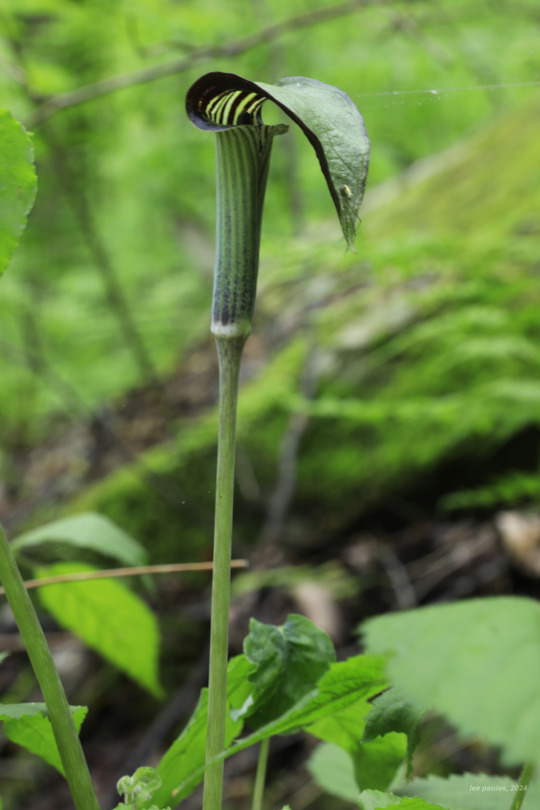

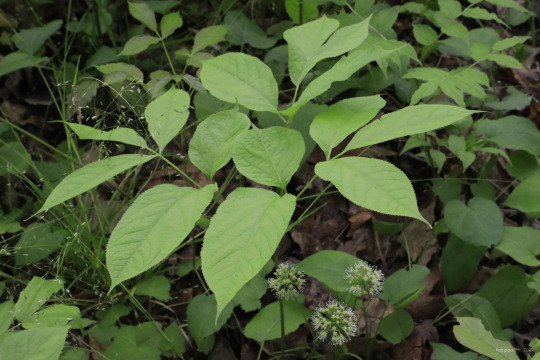
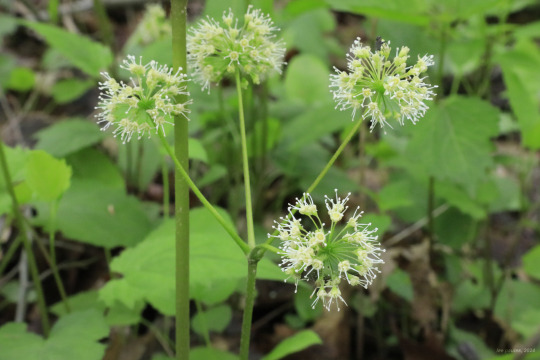
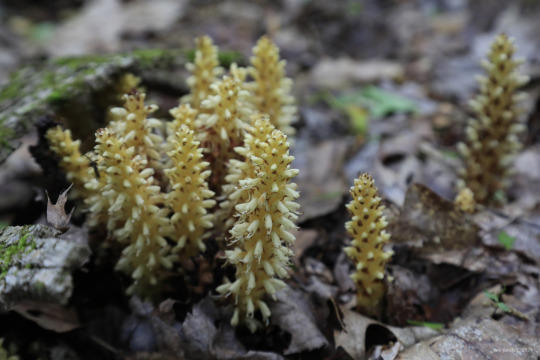

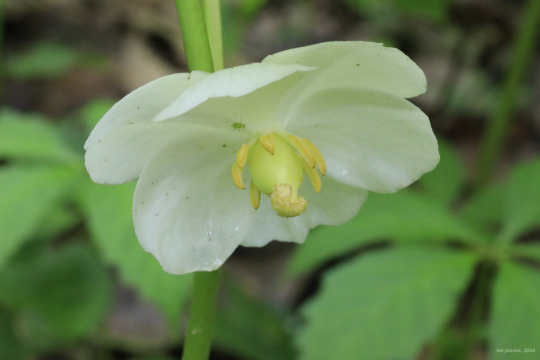

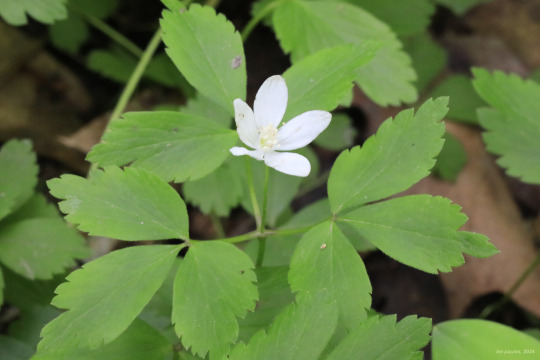

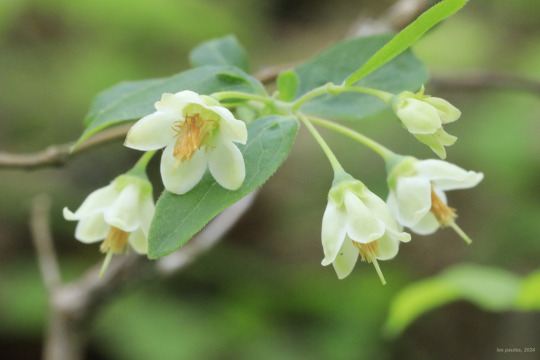




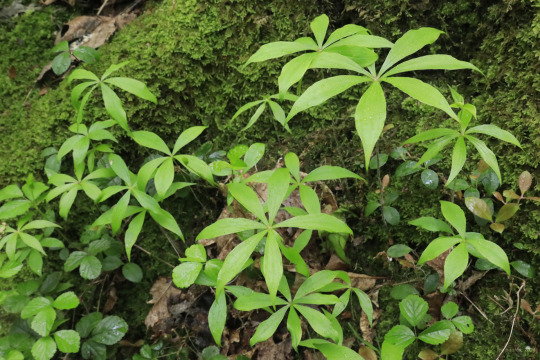
The awful weather continues in NC-WV, although thankfully not on the order of the destructive storms out west. I stayed close to home for my weekend hike, heading out to the touristy side of the Cheat River Canyon, including Raven Rock, a spectacular sandstone promontory overlooking the river. I thought I had it to myself, until a rabble of church youth singers marched in on Crocs to a caterwaul of bad turkey calls (I hope that's not their stage act). They unwittingly posed for one of my shots, adding a bit of perspective to one of the sheer sandstone cliffs that constitute Raven Rock (top photo). Second photo is the perspective from the edge of that same cliff. Storms came swooping in shortly after I made it back to the trailhead. The pink lady slippers are at peak bloom right now, along with the gorgeous deerberry, by far and away the most beautiful of the Vaccinium shrubs that grow in this area. And for those of you who search out the mountain laurel blooms in May, your time has nearly arrived. :-)
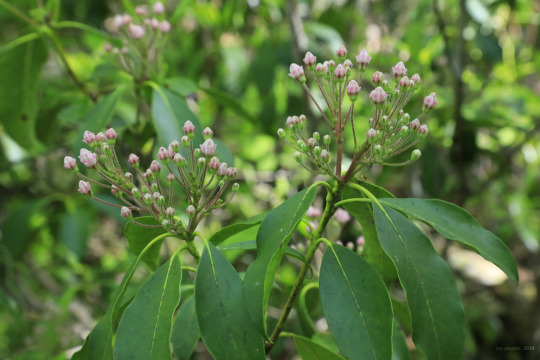
#appalachia#vandalia#west virginia#wildflowers#flora#spring#coopers rock state forest#cheat river canyon#raven rock#scott run#scott run trail#pink lady's slipper#jack-in-the-pulpit#wild sarsaparilla#cancer root#mayapple#wood anemone#perfoliate bellwort#deerberry#speckled wood lily#indian cucumber#indian cucumber-root#mountain laurel
57 notes
·
View notes
Text
Best Ayurvedic medicine for acidity in India
Acidity, also known as acid reflux, is a common problem that affects millions of people worldwide. It is characterized by a burning sensation in the chest or throat, caused by the backflow of stomach acid into the esophagus. While conventional medicine offers various treatments for acidity, many people are turning to Ayurveda, an ancient system of medicine from India, for natural and holistic remedies. This blog will explore the Best Ayurvedic medicine for acidity in India, focusing on natural and effective solutions to manage this condition.
Understanding Acidity in Ayurveda
In Ayurveda, acidity is often referred to as "Amlapitta." According to Ayurvedic principles, acidity is caused by an imbalance in the body's doshas, primarily Pitta dosha. Pitta is associated with the fire element and governs digestion and metabolism. When Pitta becomes aggravated due to factors such as unhealthy diet, stress, and lifestyle choices, it leads to excessive production of stomach acid, resulting in acidity.
Ayurvedic treatments aim to restore balance to the doshas, particularly Pitta, through dietary modifications, lifestyle changes, and the use of herbal remedies. These remedies are designed to cool and soothe the digestive system, reduce acid production, and promote overall digestive health.
Top Ayurvedic Medicines for Acidity
1. Triphala
Triphala is a traditional Ayurvedic formulation consisting of three fruits: Amalaki (Emblica officinalis), Bibhitaki (Terminalia bellirica), and Haritaki (Terminalia chebula). It is renowned for its digestive benefits and is considered one of the best Ayurvedic medicines for acidity in India. Triphala helps regulate bowel movements, detoxify the digestive tract, and balance the Pitta dosha, thereby reducing acid reflux and promoting healthy digestion.
2. Amla (Indian Gooseberry)
Amla, or Indian Gooseberry, is a potent antioxidant and a rich source of vitamin C. It is known for its cooling properties, making it effective in soothing the stomach lining and reducing acid production. Amla also enhances digestion and improves nutrient absorption, making it a valuable remedy for managing acidity.
3. Licorice Root (Yashtimadhu)
Licorice root, also known as Yashtimadhu, is a well-known herb in Ayurveda for its soothing and anti-inflammatory properties. It forms a protective layer on the stomach lining, preventing damage from stomach acid. Licorice root also helps reduce inflammation and promotes healing of the esophagus, making it one of the best Ayurvedic medicines for acidity in India.
4. Aloe Vera
Aloe vera is widely recognized for its healing and soothing properties. It helps neutralize stomach acid and reduces inflammation in the digestive tract. Aloe vera juice is commonly used to treat acidity and other digestive issues. Its cooling effect on the stomach makes it an excellent remedy for acid reflux.
5. Fennel Seeds (Saunf)
Fennel seeds are a popular digestive aid in Ayurveda. They help in relieving bloating, gas, and indigestion. Chewing fennel seeds after meals can help reduce acidity and promote better digestion. Fennel seeds have carminative properties that soothe the digestive tract and prevent acid reflux.
Dietary Recommendations for Acidity
In addition to using the best Ayurvedic medicines for acidity in India, making dietary changes is crucial for managing acid reflux. Ayurveda emphasizes the importance of a balanced diet to maintain digestive health and prevent acidity. Here are some dietary recommendations:
Avoid Pitta-aggravating foods: Spicy, oily, and fried foods can aggravate Pitta and increase acidity. It is advisable to avoid these foods and opt for lighter, easily digestible meals.
Include cooling foods: Foods like cucumbers, melons, and leafy greens have a cooling effect on the body and can help balance Pitta.
Eat smaller, frequent meals: Eating smaller, more frequent meals can prevent the stomach from becoming too full and reduce the risk of acid reflux.
Stay hydrated: Drinking plenty of water helps dilute stomach acid and aids digestion.
Avoid caffeine and alcohol: Both caffeine and alcohol can irritate the stomach lining and increase acid production, so it's best to limit or avoid them.
Lifestyle Changes for Managing Acidity
Alongside dietary modifications and the best Ayurvedic medicines for acidity in India, incorporating certain lifestyle changes can significantly improve digestive health and reduce acid reflux symptoms. Here are some lifestyle recommendations:
Stress management: Stress is a major factor that can aggravate Pitta and lead to acidity. Practicing stress-reducing techniques such as yoga, meditation, and deep breathing can help maintain a calm and balanced mind.
Regular exercise: Engaging in regular physical activity promotes healthy digestion and helps regulate the digestive system. However, it's important to avoid vigorous exercise immediately after meals.
Maintain a healthy weight: Excess weight can put pressure on the stomach, causing acid to backflow into the esophagus. Adopting a balanced diet and exercise routine can help achieve and maintain a healthy weight, thereby reducing the risk of acid reflux.
Elevate the head while sleeping: Sleeping with the head elevated can prevent stomach acid from flowing back into the esophagus during the night.
Ayurvedic Herbs and Remedies for Acidity
1. Shankhapushpi
Shankhapushpi is an Ayurvedic herb known for its calming and cooling properties. It helps balance Pitta and reduce acidity. Shankhapushpi is also beneficial for managing stress and anxiety, which can contribute to acid reflux. Consuming Shankhapushpi in the form of a powder or syrup can help alleviate acidity symptoms.
2. Guduchi (Giloy)
Guduchi, also known as Giloy, is a powerful herb in Ayurveda that supports the immune system and promotes overall health and weight management.. It has anti-inflammatory and antioxidant properties that help reduce inflammation in the digestive tract and soothe the stomach lining. Guduchi is effective in managing acidity and improving digestive health.
3. Ajwain (Carom Seeds)
Ajwain, or carom seeds, is a well-known digestive aid in Ayurveda. It has carminative properties that help relieve gas, bloating, and indigestion. Ajwain can also help reduce acidity and improve digestion. Consuming a mixture of ajwain seeds with warm water after meals can provide relief from acid reflux.
4. Pudina (Mint)
Pudina, or mint, is a cooling herb that helps soothe the digestive system and reduce acidity. Mint leaves can be consumed in the form of tea or added to meals to aid digestion. The cooling effect of mint helps balance Pitta and provides relief from acid reflux.
5. Tulsi (Holy Basil)
Tulsi, also known as Holy Basil, is a revered herb in Ayurveda for its medicinal properties. It helps reduce acid production, soothe the stomach lining, and relieve stress. Consuming tulsi leaves or tulsi tea can help manage acidity and promote digestive health.
The Role of Ayurvedic Medicine in Weight Management
In addition to managing acidity, Ayurvedic medicine also plays a significant role in weight management. Maintaining a healthy weight is essential for overall health and well-being. Ayurveda offers various herbs and remedies that support weight management and promote a balanced metabolism.
1. Guggul
Guggul is a resin extracted from the Commiphora mukul tree. It is widely used in Ayurveda for its ability to support weight management and balance cholesterol levels. Guggul helps enhance metabolism and promotes the breakdown of fats, making it an effective remedy for weight management.
2. Trikatu
Trikatu is an Ayurvedic formulation consisting of three spices: black pepper (Piper nigrum), long pepper (Piper longum), and ginger (Zingiber officinale). It is known for its digestive and metabolism-boosting properties. Trikatu helps improve digestion, increase metabolism, and promote weight loss.
3. Garcinia Cambogia
Garcinia Cambogia is a tropical fruit that contains hydroxycitric acid (HCA), known for its weight loss properties. It helps suppress appetite, reduce fat accumulation, and enhance metabolism. Garcinia Cambogia is commonly used in Ayurvedic weight management formulations.
4. Triphala
Triphala, mentioned earlier as one of the best Ayurvedic medicines for acidity in India, also plays a role in weight management. It helps detoxify the digestive system, improve digestion, and promote healthy weight loss. Triphala is a valuable addition to any weight management regimen.
5. Green Tea
Green tea is known for its antioxidant properties and its ability to support weight management. It helps boost metabolism, increase fat oxidation, and improve overall health. Consuming green tea regularly can aid in weight loss and promote a healthy weight.
Combining Ayurvedic Medicine with Modern Practices
While Ayurvedic medicine offers effective remedies for managing acidity and supporting weight management, it can be beneficial to combine these traditional practices with modern approaches. Integrating Ayurveda with a balanced diet, regular exercise, and a healthy lifestyle can provide comprehensive benefits for overall health and well-being.
1. Balanced Diet
A balanced diet is essential for maintaining digestive health and managing weight. Incorporating a variety of fruits, vegetables, whole grains, and lean proteins can provide the necessary nutrients for optimal health. Avoiding processed foods, sugary beverages, and excessive consumption of caffeine and alcohol can help reduce acidity and support weight management.
2. Regular Exercise
Engaging in regular physical activity is crucial for maintaining a healthy weight and promoting overall well-being. Exercise helps improve digestion, boost metabolism, and reduce stress. Activities such as yoga, walking, swimming, and cycling can be incorporated into daily routines for optimal health benefits.
3. Hydration
Staying hydrated is essential for digestive health and overall well-being. Drinking plenty of water throughout the day helps dilute stomach acid, support digestion, and promote detoxification. Herbal teas and infused water with cooling herbs like mint and cucumber can also provide additional benefits.
4. Stress Management
Stress is a significant factor that can contribute to acidity and weight gain. Practicing stress-reducing techniques such as meditation, deep breathing exercises, and mindfulness can help maintain a calm and balanced mind. Regular relaxation and self-care activities are essential for overall health and well-being.
Conclusion
Acidity is a common digestive issue that can be effectively managed with the best Ayurvedic medicines for acidity in India. Ayurvedic remedies, such as Triphala, Amla, Licorice Root, Aloe Vera, and Fennel Seeds, offer natural and holistic solutions for reducing acid reflux and promoting digestive health. Alongside these remedies, making dietary modifications and lifestyle changes is crucial for long-term relief from acidity.
Incorporating Ayurvedic herbs and practices for weight management can further enhance overall health and well-being. Herbs like Guggul, Trikatu, Garcinia Cambogia, and Triphala, along with a balanced diet, regular exercise, and stress management, can support healthy weight loss and maintenance.
By combining the wisdom of Ayurveda with modern practices, individuals can achieve optimal digestive health, manage acidity effectively, and maintain a healthy weight. The best Ayurvedic medicine for acidity in India offers a holistic approach to wellness, promoting harmony between the mind, body, and spirit.
Embracing Ayurvedic principles and remedies can lead to a healthier and more balanced life, free from the discomfort of acidity and the challenges of weight management.
0 notes
Text
Discover the Delights of Malai Kofta at Royal India

When experiencing authentic Indian cuisine, Royal India stands out as a premier destination for food enthusiasts. Our restaurant is dedicated to providing a memorable dining experience that captures the essence of Indian flavors and hospitality. One of our standout dishes, Malai Kofta, is a testament to our commitment to culinary excellence. Call 619-269-9999 for free booking and join us for an unforgettable meal.
The Essence of Malai Kofta
Malai Kofta is a traditional Indian dish that combines soft, melt-in-your-mouth koftas (dumplings) made from a mixture of paneer (Indian cottage cheese), potatoes, and a blend of spices, served in a rich and creamy tomato-based gravy. This vegetarian delight is a favorite among our patrons, known for its delicate balance of flavors and luxurious texture.
History and Origin of Malai Kofta
Malai Kofta has its roots in Mughlai cuisine, which originated in the kitchens of the Mughal emperors of India. This cuisine is known for its rich, creamy dishes that often incorporate nuts, dried fruits, and aromatic spices. Malai Kofta, with its indulgent gravy and tender koftas, perfectly embodies the opulence and sophistication of Mughlai cuisine.
Ingredients that Make Malai Kofta Special
At Royal India, we believe in using only the finest ingredients to prepare our dishes. For our Malai Kofta, we source fresh paneer and high-quality potatoes. The gravy is made from ripe tomatoes, onions, garlic, ginger, and a blend of spices, including garam masala, turmeric, and coriander. The addition of fresh cream and cashews gives the gravy its signature richness and smoothness.
The Art of Making Malai Kofta
Preparing Malai Kofta is a labor of love. The koftas are carefully crafted by mashing paneer and potatoes together with spices and then shaping the mixture into round balls. These are lightly fried until golden brown. The gravy is simmered to perfection, allowing the flavors to meld together beautifully. Finally, the koftas are gently added to the gravy, ensuring they soak up the delicious sauce without falling apart.
A Visual Feast: Presentation of Malai Kofta
At Royal India, we believe that a meal should be a feast for the eyes as well as the palate. Our Malai Kofta is presented in a beautifully garnished dish, topped with a swirl of fresh cream and a sprinkle of chopped coriander. The vibrant colors of the gravy and garnishes create a visually appealing dish that is sure to whet your appetite.
Pairing Malai Kofta with Complementary Dishes
To enhance your dining experience, we recommend pairing Malai Kofta with some of our other signature dishes. Naan bread or garlic naan is perfect for soaking up the rich gravy. A side of fragrant basmati rice or jeera rice complements the dish beautifully. For a complete meal, try our raita (yogurt sauce) and a refreshing cucumber salad.
Why Choose Royal India for Malai Kofta?
Royal India is more than just a restaurant; it is a place where culinary traditions are honored and shared with our guests. Our chefs are passionate about creating authentic Indian dishes that reflect the diversity and richness of Indian cuisine. When you dine with us, you can expect:
Quality Ingredients: We use only the freshest and finest ingredients in all our dishes.
Authentic Recipes: Our recipes are passed down through generations, ensuring an authentic dining experience.
Warm Hospitality: We strive to provide exceptional service and make every guest feel like part of the Royal India family.
Inviting Ambiance: Our restaurant is designed to create a warm and welcoming atmosphere, perfect for a relaxed meal with family and friends.
Visit Royal India Today
Ready to indulge in the exquisite flavors of Malai Kofta? Visit Royal India and discover why our restaurant is a favorite among locals and visitors alike. Whether you're planning a special dinner with loved ones or simply craving a delicious meal, we invite you to experience the best of Indian cuisine at Royal India.
Make a Reservation
To ensure you have a table waiting for you, we recommend making a reservation. Call us at 619-269-9999 for free booking and let us know your preferred date and time. We look forward to welcoming you to Royal India and serving you our signature Malai Kofta along with other delectable dishes.
Catering Services
Hosting a special event or celebration? Royal India offers catering services that bring the flavors of our restaurant to your gathering. From intimate dinners to large parties, we can customize a menu that suits your needs and ensures your guests have a memorable dining experience. Contact us at 619-269-9999 to discuss your catering requirements.
Experience the Magic of Malai Kofta at Home
Can't make it to our restaurant? No problem! We also offer takeout and delivery services, so you can enjoy our delicious Malai Kofta in your home. Place your order online or call us at 619-269-9999, and we'll ensure your meal is prepared fresh and delivered to your doorstep.
Malai Kofta at Royal India is more than just a dish; it's an experience. From the rich history and carefully selected ingredients to the meticulous preparation and beautiful presentation, every aspect of our Malai Kofta is designed to delight your senses. Join us at Royal India and savor the authentic flavors of India, one dish at a time.
We look forward to welcoming you soon.
Don't miss out on the chance to enjoy the best Malai Kofta in town. Call 619-269-9999 for free booking or visit Royal India today. Whether dining in, ordering takeout or booking our catering services, we promise a culinary experience that will leave you wanting more.
0 notes
Text
Ayurvedic Treatment For Hypertension In India | Arogyadham

Hypertension, commonly known as high blood pressure, is a prevalent health concern that affects millions globally. Characterized by elevated blood pressure levels, this condition can lead to severe complications, including heart disease, stroke, and kidney failure. While conventional medicine offers various treatments for hypertension, Ayurveda, the ancient Indian system of medicine, provides holistic and natural approaches to managing and treating this condition. At Arogyadham, we integrate traditional Ayurvedic Treatment For Hypertension.
Understanding Hypertension in Ayurveda
In Ayurveda, hypertension is often associated with an imbalance in the body's doshas - Vata, Pitta, and Kapha. The condition is primarily linked to an aggravated Pitta dosha, which is responsible for the heat and metabolic processes in the body. When Pitta is imbalanced, it can lead to increased blood pressure. Additionally, Vata and Kapha imbalances can also contribute to hypertension, causing symptoms such as stress, anxiety, and fluid retention.
Ayurvedic Diagnosis and Approach
The Ayurvedic approach to treating hypertension involves a thorough understanding of an individual's unique constitution (Prakriti) and the specific imbalances (Vikriti) present. At Arogyadham, our experienced Ayurvedic practitioners conduct detailed consultations to assess these factors. This personalized approach ensures that the treatment plan is tailored to the individual's needs, addressing the root cause of hypertension rather than just its symptoms.
Dietary Recommendations
Diet plays a crucial role in managing hypertension in Ayurveda. Specific dietary guidelines help in balancing the doshas and maintaining optimal health:
Pitta-Pacifying Foods: Include cooling and soothing foods such as cucumber, leafy greens, melons, and dairy products like milk and ghee. Avoid spicy, salty, and sour foods that aggravate Pitta.
Vata-Pacifying Foods: Consume warm, nourishing foods like cooked vegetables, whole grains, and legumes. Avoid cold, raw, and dry foods that increase Vata.
Kapha-Pacifying Foods: Opt for light and easy-to-digest foods such as fruits, vegetables, and spices like ginger and turmeric. Avoid heavy, oily, and sugary foods that increase Kapha.
Herbal Remedies
Ayurveda utilizes various herbs known for their antihypertensive properties. Some of the effective herbs include:
Arjuna (Terminalia arjuna): Known for its cardioprotective properties, Arjuna helps in strengthening the heart and regulating blood pressure.
Ashwagandha (Withania somnifera): This adaptogenic herb helps in reducing stress and anxiety, which are common contributors to hypertension.
Sarpagandha (Rauwolfia serpentina): Traditionally used to manage high blood pressure, Sarpagandha has calming effects on the nervous system.
Lifestyle Modifications
Ayurveda emphasizes the importance of a balanced lifestyle in managing hypertension. Key recommendations include:
Regular Exercise: Engage in moderate physical activities like yoga, walking, and swimming to maintain cardiovascular health and reduce stress.
Stress Management: Practice relaxation techniques such as meditation, deep breathing exercises, and mindfulness to manage stress effectively.
Adequate Sleep: Ensure a regular sleep schedule with 7-8 hours of restful sleep each night to support overall health.
Panchakarma Therapy
Panchakarma, the Ayurvedic detoxification therapy, plays a significant role in managing hypertension. This therapy involves a series of treatments designed to cleanse the body of toxins and restore balance to the doshas. At Arogyadham, our Panchakarma treatments are customized to suit the individual's needs, promoting overall well-being and reducing hypertension symptoms.
Conclusion
Hypertension requires a comprehensive and holistic approach for effective management. At Arogyadham, our Ayurvedic Treatment For Hypertension focus on balancing the doshas, detoxifying the body, and promoting a healthy lifestyle to manage hypertension naturally. By integrating personalized dietary plans, herbal remedies, lifestyle modifications, and Panchakarma therapy, we aim to provide sustainable and long-lasting relief from high blood pressure. Embrace the wisdom of Ayurveda at Arogyadham for a healthier and balanced life.
0 notes
Text
Seasonal Ayurvedic Treatments: Adapting to Dubai's Climate

Being a bustling metropolis with rich cultures and rapid growth brings in, by itself, its own unique climate challenge for Dubai. In this respect, the city either way stands in dire need of flexibility related to health and well-being from summer heat to mild winters and easy transitional seasons. Ayurveda is the ancient Indian science of life, and these holistic remedies have been inculcated according to the changing seasons.
Cycling our energies and practices with assistance from an Ayurvedic hospital in Dubai will bring balance and keep things moving, maintaining well-balanced adjustments with seasonal variations. The following blog explores 'Seasonal Ayurvedic Treatments: Adapting to Dubai's Climate' in a more meaningful way to adapt Ayurvedic remedies for Dubai's environment so that one can stay hale and hearty throughout the year.
Knowing about the climate of Dubai for Ayurvedic practices
The weather of Dubai is characterized by very hot summers, which often reach beyond 40°C or 104°F, with the warmer ones in winter, when it becomes no less hot. Nevertheless, short spring and autumn can make their fast changes in humidity and temperature felt on one's health. The milder winter months bring an imbalance in Vata, causing dry skin and joint problems, while the most strong summer heat may further cause dehydration, heat exhaustion, and other imbalances in Pitta.
The Art of Seasonal Adaptation in Ayurveda
Ayurveda medicine is very attached to the cycles of nature. In this old science, Vata corresponds to fall, Pitta corresponds to summer, and Kapha corresponds to spring; these are the three ruling periods of the year. There are certain qualities in every season and specific effects on the doshas in the human organism. Applying specific dietary, lifestyle, and therapeutic habits to our awareness of these factors may help us retain balance and health.
Pitta Dosha Hydrating and Soothing
Dietary Modifications
Dubai summers are dominated by the heat and intensity of the Pitta dosha. According to Ayurveda, a diet that cools, moisturizes, and calms helps in balancing the excess of Pitta. Add to your diet foods like melons, cucumbers, leafy greens, and coconut water. It is always better to avoid sour, oily, and spicy meals since they can irritate the superheating of Pitta. Go in for light meals that are easily digestible. The use of herbs like fennel, mint, and coriander may be quite effective as they have a cooling effect.
Lifestyle Habits
You should drink a minimum of eight glasses of water throughout the whole day you have. Some herbs that will help you in keeping your body cool are peppermint, chamomile, and aloe vera juice. Dressing up in loose light-colored clothes with breathing effects like linen and loose cotton can be an effective way of keeping cool. Too much direct sunlight should be avoided, but cooling activities, such as yoga or swimming, are good. Massaging with natural, cooling oils like coconut or sunflower oil according to your skin frequently will help you nourish and balance the Pitta.
Ayurveda Medicines
Treatments that pacify pita are of utmost importance during summer. One of those treatments is Shirodhara, which reduces tension and calms the mind. Some warmed oil is only gently applied to the forehead in this treatment. Abhyanga, a full body massage with oil, will help to soothe and even cool down the body. A herbal face, together with ingredients like rose water and sandalwood, may have an even greater cooling effect on the heat.
Autumn: Vata Dosha Balancing and Nourishing Dietary Adjustments
Vata is straightforwardly associated with rainfall and is characterized by movement, cold, and dryness. Think about healthy and heavy meals to bring balance to Vata. Warm, well-cooked foods full of good fats, such as ghee and sesame oil, are good. Include whole grains, root vegetables, and warming spices in your diet, such as cloves, cinnamon, and ginger. Shun cold, raw foods; limit alcohol and caffeine.
Lifestyle Habits
Wear scarves and caps to keep warm and protected from the cold autumn winds. Routine works to Keep the generally imbalanced energies of Vata steady and calm. The body and mind basics work better through breathing meditation and easy yoga practices. Get enough rest and avoid overworking.
Ayurveda Remedies
In the fall, Ayurvedic treatment should focus on nourishing and centering the body. Abhyanga with warm sesame oil is especially helpful for Vata imbalances. Nasya can soothe dryness and lubricate the passages. The skin may be further soothed by steam treatments and warm baths with herbs added to the water for extra comfort and hydration.
Warming and Stimulating the Kapha Dosha Throughout Winter
Dietary Modifications
Although winters in Dubai are relatively mild compared with most other places, they still have the potential to create Kapha imbalances. On the other hand, Kapha likes warming, light, and invigorating food. Favor foods that have tastes that are hot, bitter, and astringent. Add to your diet such things as turmeric, ginger, and garlic. Avoid heavy, greasy, and sweet meals, for they will increase Kapha.
Lifestyle Habits
To offset lethargy, which Kapha is likely to give, keep active. Exercise in a daily routine will help keep the energy balanced. All the activities you can do to improve your lifestyle include jogging, expansive yoga, brisk walking, etc. However, do not be excessively wet in your junction; ensure good ventilation, and dress up in warm attire to off-set cold and damp. Dry brushing, Ujjayi might help in improving circulation and really clearing out the excess Kapha in your body.
Ayurveda Medicines
Treatments that are mainly aimed at balancing the Kapha energy mostly concentrate on stirring and energizing the body. A dry powder massage, called Udwarthanam, may help stimulate blood circulation and minimize excess Kapha. Herbal steam immersion might also prove to be beneficial in removing impurities and opening up the pores. Regular oil massages using oils like sesame or mustard oil, which have a heating effect, may also help in the balancing of Kapha during the cold winter months.
Body Purification and Renewal During Spring
Dietary Changes
Spring is an excellent time of the year to clean the body from pooled toxins, as, basically, it is a time of renewal and cleansing. Increase fresh, light, and cleansing foods. Bob up on green vegetables; eat plenty of green vegetables, sprouts, and fruits that are in season. Bitter and astringent tastes have a cleansing action on the body.
Traditions of Lifestyle
Excellent purification methods that are most effective in the spring season are fasting or detox dieting. Some of the exercises that are stimulating and help detoxify are dancing, hiking, and aerobic training. Practices of pranayama and breathing exercises may perhaps help build up energy and the clearing of the respiratory system.
Ayurveda Medicines
Springtime Ayurvedic therapy builds and the main goal should include detoxification and renewal. It can be supplemented by an intensive detoxification treatment called panchakarma to get rid of these toxins and help in the rebalancing process. Massage therapies directed toward the lymph nodes and herbal steam will further stimulate the body's ability for self-cleansing. Integrate these with other restorative therapies like Shirodhara and Abhyanga to rejuvenate the body and mind.
Ayurvedic Circle, Dubai
Bringing the knowledge of Ayurvedic principles to Dubai's environment requires one to understand the special challenges each season brings and make deliberate changes in nutrition, lifestyle, and therapies. By coming into synchrony with the cycles of nature, we may keep our balance and attain health throughout the year. Ayurveda gives a timeless, adaptable way to health—whether you use it to cool your body in the sweltering summer heat, anchor and nourish in the fall, or warm and invigorate in the winter.
Bring some elegance and vigor into dealing with Dubai's environment by incorporating these Ayurvedic practices along with treatments like Panchakarma in Dubai into your everyday routine to make sure you're well-balanced, healthy, and full of energy throughout the year.
#ayurvedic hospital dubai#ayurvedic center in dubai#panchakarma#massage therapy#panchakarma treatment
0 notes
Text
Seasonal Vegetables to Buy Online in Chennai: A Month-by-Month Guide

Navigating the vibrant markets of Chennai can be an exhilarating experience, but sometimes convenience takes precedence. For those who prefer the ease of online shopping, knowing which vegetables are in season can ensure that you get the freshest and most flavorful produce. This comprehensive month-by-month guide will help you make informed choices about the seasonal vegetables to Buy Fresh vegetables online.
January: A Fresh Start to the Year
Carrots and Beets
January is the perfect time to indulge in root vegetables. Carrots and beets are at their peak, offering a sweet and earthy flavor ideal for soups, stews, and salads.
Cauliflower
Versatile and nutritious, cauliflower is abundant in January. Use it in curries, roasted dishes, or even as a low-carb alternative to rice.
Green Peas
Fresh green peas are a seasonal delight in January. They add a sweet crunch to any dish and are excellent in pulao, parathas, and stir-fries.
February: Embrace the Cool
Spinach
Rich in iron and vitamins, spinach thrives in February's cooler climate. Perfect for palak paneer, spinach salads, and smoothies.
Radishes
Crisp and slightly spicy, radishes add a refreshing crunch to salads and pickles. February's radishes are particularly vibrant and flavorful.
Tomatoes
Though available year-round, tomatoes are especially juicy and flavorful in February. Use them in gravies, sauces, or simply as a salad ingredient.
March: The Transition Month
Cabbage
Cabbage is plentiful in March. Its crunchiness and mild flavor make it perfect for stir-fries, salads, and Indian curries.
Sweet Potatoes
A nutritious and sweet option, sweet potatoes are great for baking, frying, or adding to curries. Their versatility makes them a March favorite.
Capsicum
Also known as bell peppers, capsicums add color and a slight sweetness to your dishes. March is the best time to enjoy them fresh and crisp.
April: Warmer Days Ahead
Cucumbers
As temperatures rise, cucumbers offer a hydrating and cooling effect. Perfect for salads, raitas, and as a snack.
Pumpkin
Pumpkin is versatile and nutritious, ideal for soups, curries, and desserts. April's pumpkins are tender and full of flavor.
Bottle Gourd
Also known as lauki, bottle gourd is perfect for summer. It is light, nutritious, and can be used in soups, curries, and desserts.
May: Peak Summer Produce
Bitter Gourd
Despite its bitterness, bitter gourd is highly nutritious and popular in Indian cuisine. May offers the freshest produce, ideal for stir-fries and pickles.
Lady’s Finger
Also known as okra or bhindi, lady's finger is perfect in curries and stir-fries. May is when they are most tender and flavorful.
Brinjal
Brinjal, or eggplant, comes in many varieties, all abundant in May. Use it in bharta, sambar, or as a grilled vegetable.
June: Monsoon Harvest
Green Beans
Green beans are crisp and versatile. They can be used in curries, salads, and stir-fries, providing a fresh crunch.
Amaranth Leaves
Nutritious and versatile, amaranth leaves are excellent in soups, stews, and stir-fries. June is when they are most tender.
Cluster Beans
Also known as guar, cluster beans are great for curries and stir-fries. June is the peak season for these beans.
July: Mid-Year Bounty
Snake Gourd
Snake gourd is perfect for light, nutritious dishes. July is the best time to enjoy it in curries, stews, and salads.
Ash Gourd
Ash gourd, or winter melon, is ideal for soups, curries, and desserts. July's produce is fresh and flavorful.
Drumsticks
Drumsticks are a popular addition to sambar and other South Indian dishes. July offers the freshest and most tender drumsticks.
August: A Rich Harvest
Yam
Yam is a nutritious root vegetable, perfect for curries and fries. August is when it is most abundant and flavorful.
Chow Chow
Also known as chayote, chow chow is excellent in curries and stews. Its mild flavor and crunchy texture are best in August.
Spinach
Spinach makes a return in August, offering fresh greens for salads, curries, and smoothies.
September: The Harvest Continues
Colocasia Leaves
Colocasia leaves are used in traditional dishes like patra. September offers the freshest leaves, perfect for cooking.
Ivy Gourd
Also known as tindora, ivy gourd is great for stir-fries and curries. September's produce is particularly fresh and tender.
Turnips
Turnips are versatile and nutritious, ideal for roasting, stews, and curries. September is when they are at their best.
October: Prepping for Festivities
Fenugreek Leaves
Fenugreek leaves add a unique flavor to dishes. October is the best time to enjoy them in curries, parathas, and salads.
Carrots
Carrots return in October, offering sweet and crunchy goodness for salads, soups, and desserts.
Radishes
Radishes are back, adding a spicy crunch to your dishes. October's radishes are fresh and flavorful.
November: Cool Season Crops
Green Peas
Green peas return in November, perfect for pulao, parathas, and salads.
Cauliflower
Cauliflower is back, versatile for curries, roasted dishes, and as a rice substitute.
Cabbage
Cabbage is abundant again, ideal for stir-fries, salads, and curries.
December: Festive Flavors
Spinach
Spinach returns, offering fresh greens for a variety of dishes.
Tomatoes
December tomatoes are juicy and flavorful, perfect for sauces, gravies, and salads.
Beets
Beets are back, adding sweetness and color to your dishes.
Conclusion
Eating seasonal online vegetable shopping in chennai is not only a delicious and nutritious choice but also a sustainable one. By following this month-by-month guide, you can ensure that you always have the freshest produce on your plate. Chennai's vibrant online market offers a plethora of options, making it easy to incorporate seasonal vegetables into your diet. Enjoy the bounty of each season and support local farmers by choosing seasonal produce.
0 notes